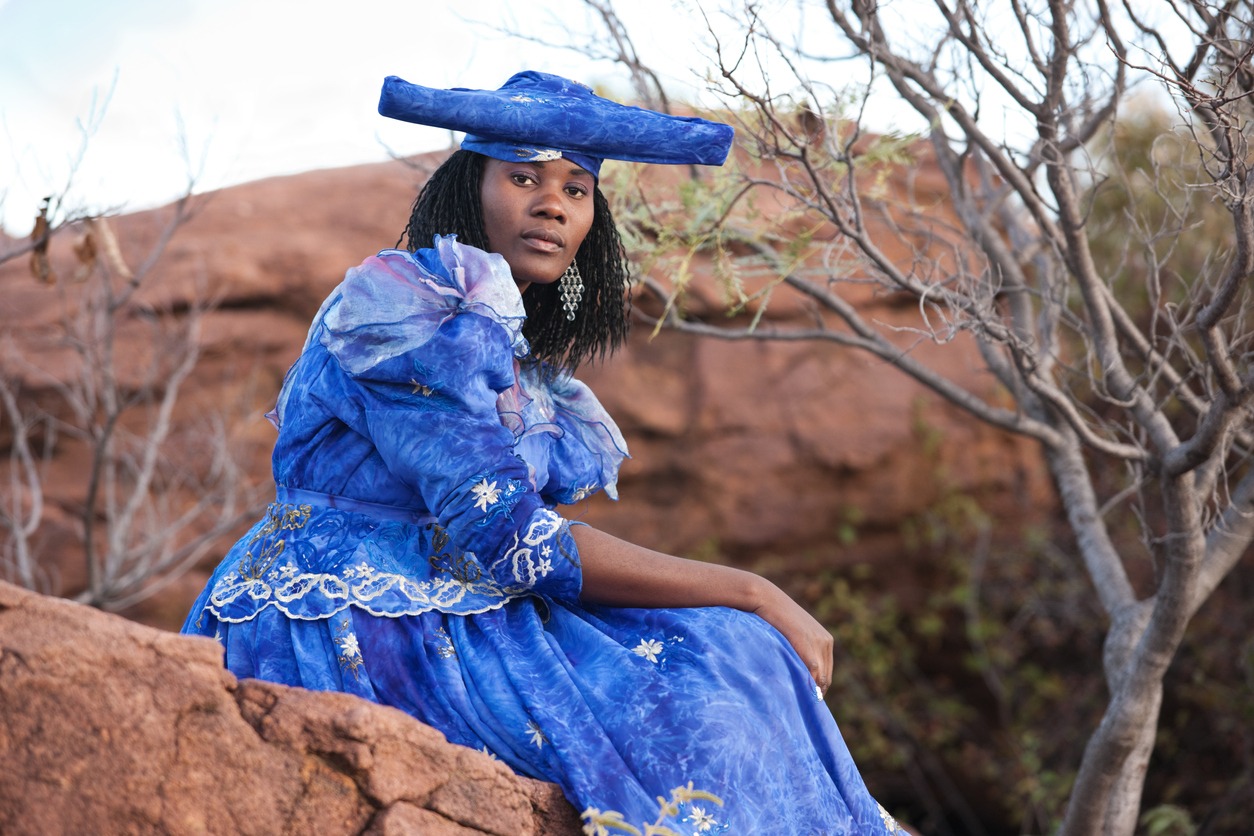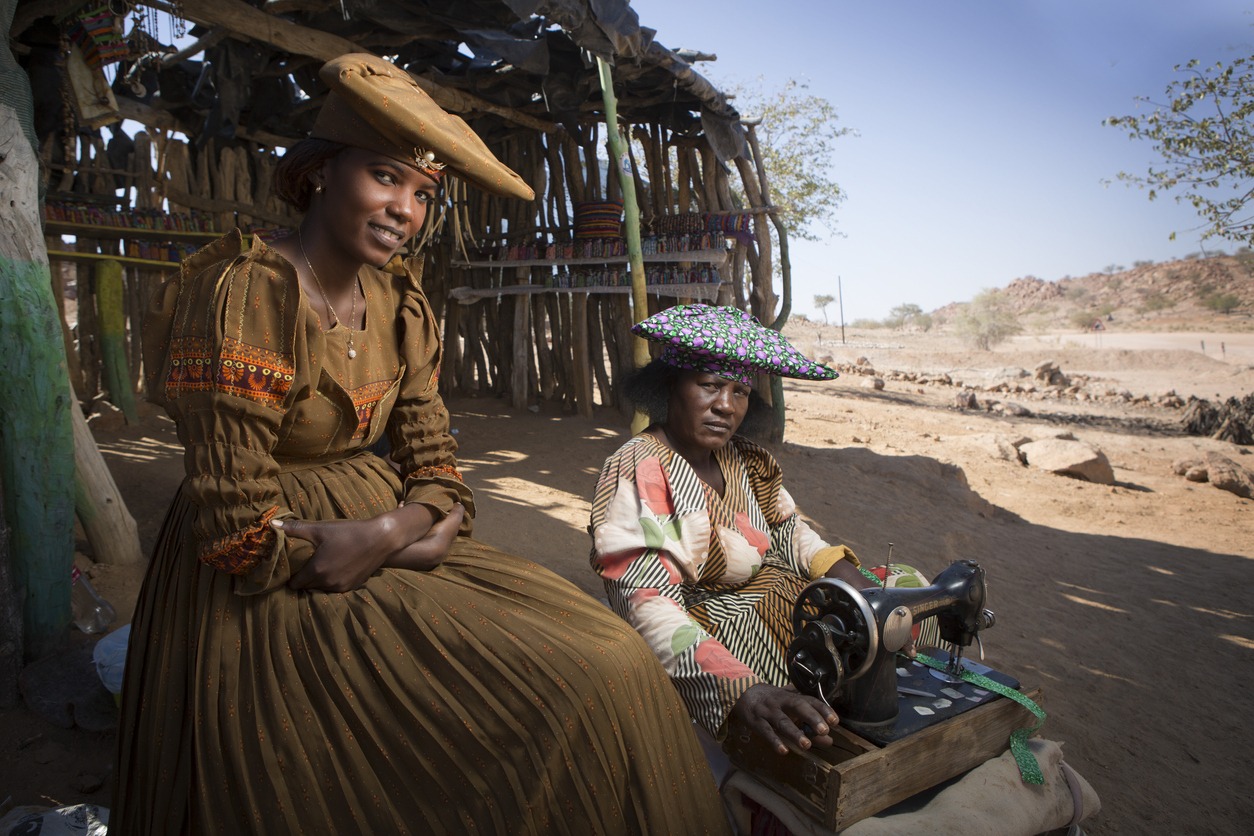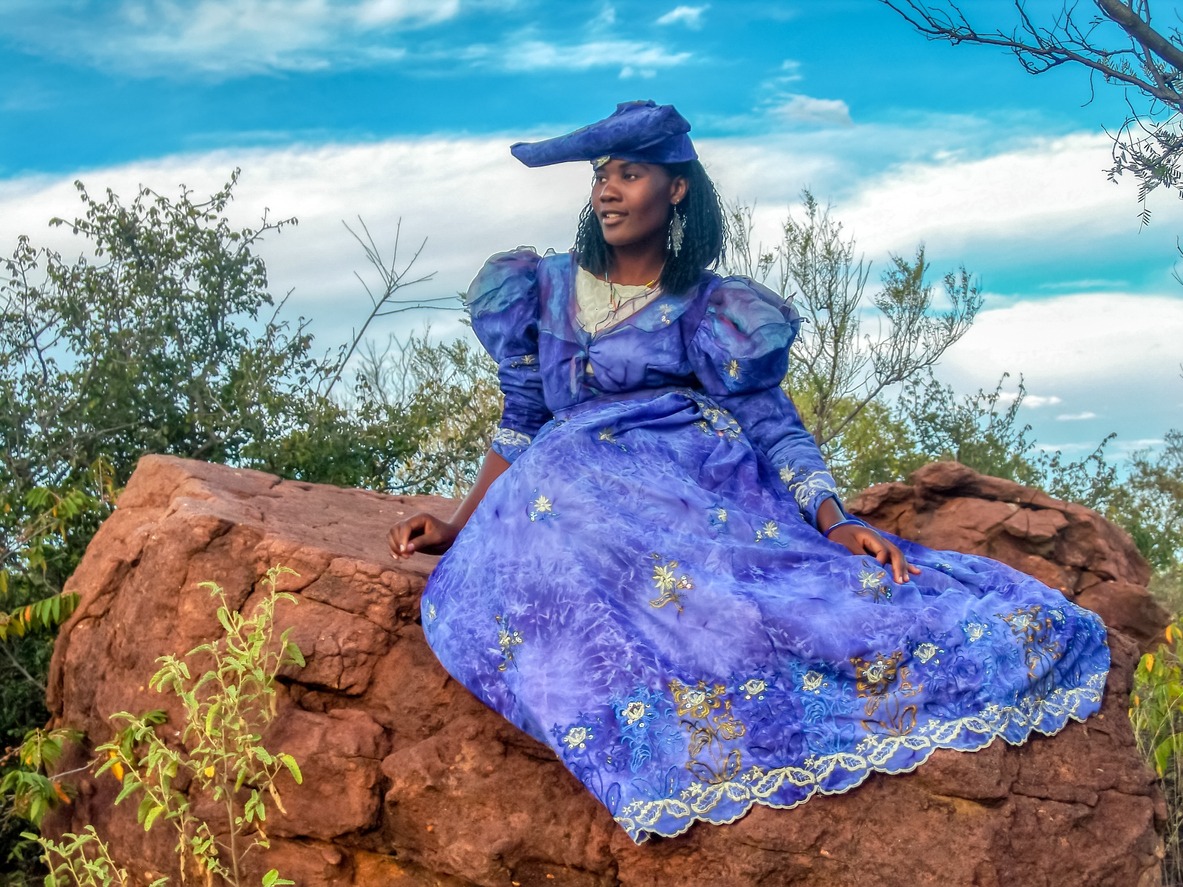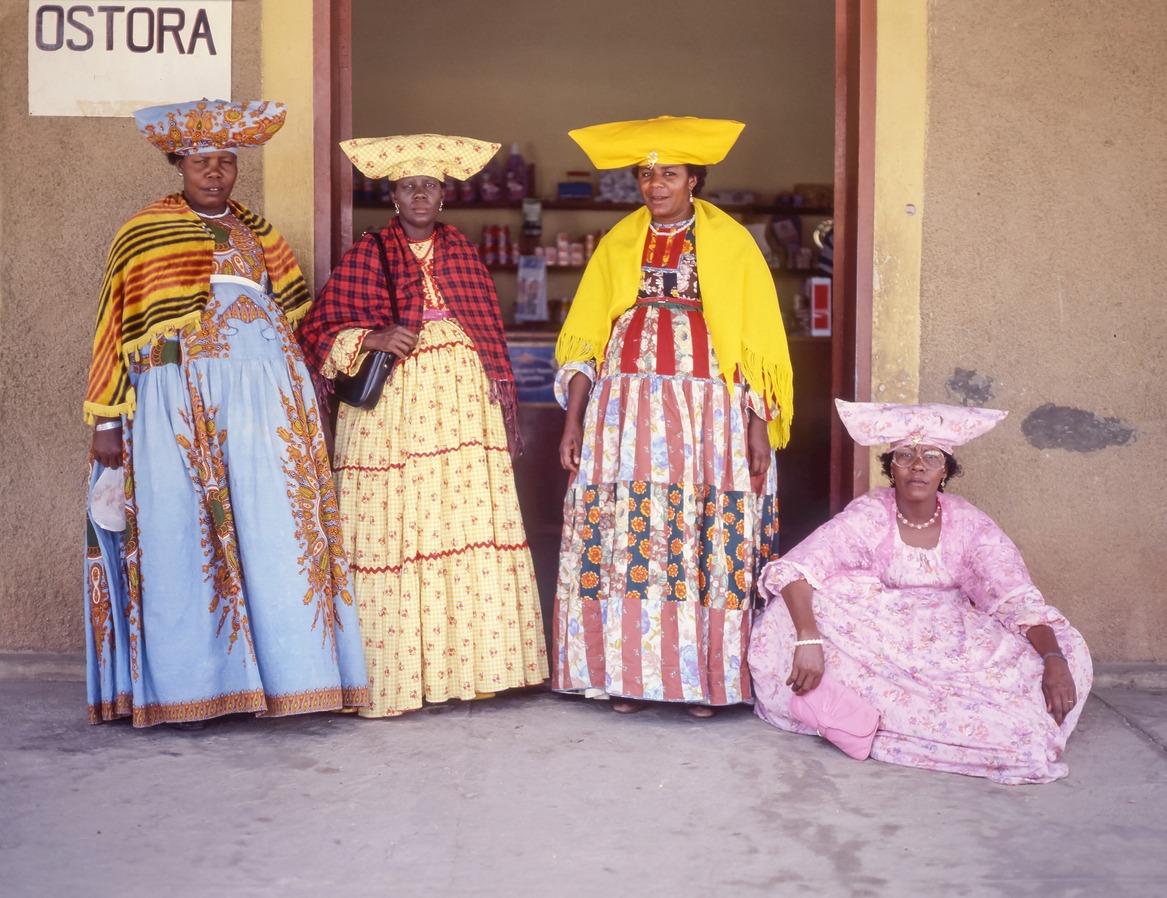The Herero dress of Namibia stands as a unique fusion of traditional African and Victorian European styles. This distinctive attire, characterized by its vibrant colors and intricate designs, tells a story of cultural intersection and adaptation. Tracing its roots back to the colonial era, the Herero dress has evolved over time, becoming a symbol of identity and resilience for the Herero people of Namibia.
In this article, we’ll discuss the intriguing question of why the Herero dress reflects Victorian-era styles. We will explore the historical context of the Herero people and their encounters with European colonizers, specifically focusing on how these interactions influenced the traditional dress. Understanding this blend of styles offers a glimpse into the complex tapestry of cultural exchange and the enduring impact of history on contemporary fashion.
Historical Context
The history of the Herero people and their dress is deeply intertwined with the colonial past of Namibia. To fully grasp the Victorian influence on the Herero dress, it’s essential to understand both the indigenous history of the Herero people and the European colonization that dramatically altered their cultural landscape.
The Herero People Pre-Colonization
Before European contact, the Herero were primarily pastoralists, known for cattle rearing in the arid landscapes of modern-day Namibia. Their traditional attire was quite different from what we see today, primarily made from animal skins and designed for the practical needs of a pastoral lifestyle.
The Arrival of German Colonizers
The late 19th and early 20th centuries marked a significant turning point with the arrival of German colonizers in Namibia. This period introduced new materials, styles, and cultural influences to the region, including Victorian fashion, which was predominant in Europe at the time.
Victorian Era and Its Fashion Trends
The Victorian era, named after Queen Victoria of the United Kingdom, was known for its distinct fashion style. This style was characterized by modesty, with high-necked dresses, long sleeves, and voluminous skirts. These fashion trends were introduced to Namibia through German settlers and missionaries, who often brought their own clothing and cultural practices with them.
The Herero-German Relations
The relationship between the Herero people and German colonizers was complex and fraught with conflict. The early 1900s were marked by resistance and rebellion against colonial rule, notably the Herero and Namaqua Wars. Despite the oppressive nature of colonial rule, there was a transfer of cultural elements, including fashion.
Adoption and Adaptation of Victorian Styles
In a unique blend of resistance and assimilation, the Herero began to incorporate elements of Victorian fashion into their traditional dress. This adaptation was not mere imitation but a creative and selective process, where the Herero infused their cultural identity into these foreign styles.
The Symbolic Resistance
The adoption of Victorian styles by the Herero people also served as a form of silent resistance. By embracing and transforming the fashion of their colonizers, they reclaimed power and agency in a period of oppression. The evolution of the Herero dress became a symbol of resilience, a quiet yet powerful assertion of identity amidst the tumultuous backdrop of colonial rule.
The historical context of the Herero dress is a narrative of cultural survival and adaptation. It reflects a period where the Herero people navigated the complexities of colonial influence, forging a unique identity that resonates in their distinctive dress, a blend of indigenous heritage and Victorian fashion.
Elements of Victorian Influence
The Herero dress of Namibia, while rooted in indigenous tradition, prominently features elements derived from Victorian fashion. This section explores these Victorian influences, highlighting how they have been seamlessly integrated into the Herero dress, creating a unique cultural symbol.
Structural and Design Elements
- Silhouette and Structure: The most noticeable Victorian influence is the dress’s silhouette. The Herero dress incorporates the voluminous skirts characteristic of Victorian fashion. These full skirts often include multiple layers of fabric, creating a sense of grandeur and formality.
- Sleeves and Necklines: Reflecting Victorian modesty, the Herero dress typically features high necklines and long sleeves. These elements are a stark contrast to the traditional pre-colonial Herero attire, which was more practical for the warm Namibian climate and less conservative in design.
Fabric and Patterns
- Introduction of New Fabrics: The colonial era introduced new materials to the Herero people, such as cotton and wool, which were not native to Namibia. These fabrics allowed for more elaborate designs and durability, essential for structured Victorian-style dresses.
- Patterns and Colors: While the Victorian era favored more subdued colors, the Herero dress adopted vibrant colors and intricate patterns. This fusion creates a visually striking garment that honors both Victorian and African aesthetics.
Headwear
- Victorian-Inspired Hats: A distinctive feature of the Herero dress is the elaborate headwear, often resembling the bonnets worn by Victorian women. These hats, known as ‘otjikalva,’ are crafted to symbolize the horns of cattle, reflecting Herero’s pastoralist heritage.
- Symbolism and Adaptation: The adoption of Victorian-style headwear and its adaptation to represent something deeply significant to Herero culture is a clear example of how foreign influences were not just adopted but also transformed to hold cultural meaning.
Embellishments and Accessories
- Lace and Embroidery: Victorian dresses often featured detailed lacework and embroidery, elements that have been adapted in the Herero dress. These embellishments add a layer of elegance and complexity, mirroring the Victorian era’s fascination with intricate detailing.
- Accessories: While the Herero dress does not typically include the corsets and petticoats common in Victorian fashion, it does occasionally incorporate accessories like brooches and neckpieces, which were popular in Victorian times.
Cultural and Symbolic Integration
The integration of Victorian elements into the Herero dress goes beyond mere aesthetic borrowing. It represents a complex interplay of power, resistance, and identity. By adopting and adapting the fashion of their colonizers, the Herero people created a unique form of cultural expression that speaks to their resilience and adaptability.
The Victorian influence on the Herero dress is evident in its structure, design, fabric choices, and accessories. However, this influence is not a simple case of imitation. Instead, it represents a deliberate and creative adaptation of foreign elements into a deeply meaningful cultural symbol.
Cultural Significance and Adaptation
The Herero dress, with its Victorian influences, is more than just a fashion statement; it’s a vibrant emblem of cultural identity, resilience, and adaptation.
Expression of Identity
The Herero dress is a powerful symbol of ethnic identity and pride. Despite the tumultuous history of colonialism, the dress allows the Herero people to reclaim and celebrate their heritage. Each element of the dress tells a story, whether it’s the cattle-horn-inspired hats that reflect their pastoral roots or the Victorian styles that narrate a history of adaptation and survival.
Role in Ceremonies and Daily Life
- Ceremonial Use: The Herero dress is often worn during important cultural ceremonies, including weddings, funerals, and festivals. It plays a crucial role in these events, serving as a connector to the past and a celebration of cultural continuity.
- Everyday Significance: While the dress is prominent in ceremonies, it is also worn in everyday life, reflecting the Herero’s deep connection to their cultural identity. The choice to wear the dress daily is a statement of pride and a living expression of their heritage.
Adaptation Over Time
Over time, the Herero dress has evolved. While maintaining its distinctive Victorian-inspired silhouette, it has seen variations in fabric patterns, colors, and designs, reflecting the dynamic nature of Herero culture. Modern influences have not been shunned but rather integrated into the dress. This includes the use of contemporary fabrics and the adaptation of the dress for modern practicalities, ensuring its relevance in the current era.
Symbol of Resistance and Resilience
In the face of colonial efforts to suppress indigenous cultures, the adaptation of the Victorian dress became an act of resistance. It stood as a refusal to let go of Herero’s identity and a means of maintaining a connection to their history and values. The continued use and evolution of the dress symbolize the resilience of the Herero people. It represents their ability to endure, adapt, and thrive despite historical challenges.
Intergenerational Transmission
The knowledge and skills involved in making and wearing the Herero dress are passed down through generations. This transmission is a crucial aspect of preserving Herero culture and history. Younger Hereros continue to embrace the dress, often adding their interpretations or combining it with modern elements, indicating a living, evolving tradition.
The Herero dress of Namibia, with its Victorian influences, is a touching symbol of cultural identity, history, and adaptation. It goes beyond being merely a garment; it is a canvas that narrates the story of a people, their struggles, their pride, and their unyielding spirit.
Modern Interpretations and Evolutions
The Herero dress, while deeply rooted in history and tradition, is not a static symbol. It continues to evolve, incorporating modern interpretations that reflect the changing times and the dynamic nature of Herero culture. This section explores the contemporary trends and transformations of the Herero dress, highlighting its ongoing relevance in today’s world.
Contemporary Trends in Herero Fashion
- Incorporation of Modern Fabrics and Designs: Today’s Herero dresses often feature modern fabrics, including synthetic materials that offer a wider range of colors and patterns. The integration of contemporary design elements shows the adaptability of the Herero people to modern fashion trends.
- Blending Tradition with Modernity: Younger generations are creatively blending traditional styles with modern fashion elements. This includes alterations in the dress’s cut, length, and accessories to suit contemporary tastes and practicalities.
Role of Fashion Designers and Artists
Namibian fashion designers and artists play a significant role in reinterpreting the Herero dress. They experiment with different materials, patterns, and designs, pushing the boundaries of traditional styles while maintaining the dress’s cultural essence.
Some of these modern interpretations have gained international attention, showcasing Herero culture on global platforms and fashion stages. This exposure helps to preserve and promote Herero heritage on a worldwide scale.
Influence of Global Fashion Trends
Innovative Interpretations: Namibian fashion designers and artists play a significant role in reinterpreting the Herero dress. They experiment with different materials, patterns, and designs, pushing the boundaries of traditional styles while maintaining the dress’s cultural essence. Some of these modern interpretations have gained international attention, showcasing Herero culture on global platforms and fashion stages. This exposure helps to preserve and promote Herero heritage on a worldwide scale.
The Dress in Modern Media and Publicity
The Herero dress has found its way into various forms of media, including films, photography, and social media. These platforms serve as powerful tools for cultural expression and education, allowing the Herero people to tell their stories and share their heritage with a broader audience. The visibility of the Herero dress in modern media underscores its role as a form of soft power. It’s a means for the Herero people to assert their cultural presence and influence in the global arena.
The Future of Herero Dress
There is a growing emphasis on sustainability in fashion. The Herero community is increasingly aware of the environmental impact of clothing production, leading to a focus on sustainable practices in creating their traditional attire.
The youth play a crucial role in the evolution of the Herero dress. Their perspectives and innovative approaches ensure that the dress remains a living, breathing part of Herero culture, adaptable to the times while retaining its historical and cultural roots.
The Herero dress of Namibia is not just a relic of the past but a living, evolving expression of identity. Its adaptation to modern trends and interpretations underscores the dynamic nature of Herero culture.
The Impact of Colonialism on Fashion
The story of the Herero dress in Namibia is a vivid example of how colonialism has had a profound impact on fashion in various cultures. This section explores the broader implications of colonial influence on fashion, examining both the immediate effects and the lasting legacies.
Introduction of New Styles and Materials
Colonial powers introduced Western styles and materials to their colonies, often as a part of a larger effort to impose their culture and values. This introduction fundamentally altered traditional clothing styles in many colonized societies. Colonization also brought new materials and textiles previously unavailable to these regions. This access allowed for new types of clothing and experimentation with fashion.
Cultural Suppression and Assimilation
In many cases, colonial powers actively suppressed indigenous fashion as a way to control and assimilate colonized populations. Traditional garments were often deemed ‘inferior’ or ‘uncivilized,’ leading to a decline in their use. In response, many colonized peoples adapted their traditional attire, integrating elements of colonial fashion. This adaptation was not merely an act of conformity but often a subtle form of resistance and a means of survival.
Fusion of Fashion Styles
The interaction between colonizers and the colonized led to the emergence of hybrid fashion styles. These styles blended elements of both indigenous and colonial fashions, creating unique, culturally mixed garments. These hybrid garments often became symbolic representations of the complex and often painful history of colonialism, embodying stories of conflict, adaptation, and resilience.
Post-Colonial Fashion Movements
In the post-colonial era, there has been a movement in many countries to reclaim and revive traditional fashion styles. This movement is part of a larger effort to recover cultural identity and heritage that was suppressed during colonial rule. Fashion has become a powerful tool for decolonization, allowing people to express their identity, tell their history, and challenge the narratives imposed by colonial powers.
Global Impact and Perspectives
The globalization of fashion has led to greater exposure and appreciation of diverse fashion styles, including those influenced by colonialism. Today’s fashion industry is marked by a rich cross-cultural exchange, with designers drawing inspiration from a variety of cultural backgrounds, including those shaped by colonial histories.
The impact of colonialism on fashion is far-reaching and multifaceted. It has led to the suppression, transformation, and eventual resurgence of traditional fashion styles in colonized cultures. The Herero dress of Namibia is a testament to this complex history, demonstrating how fashion can be a powerful medium for expressing cultural identity, narrating history, and challenging the legacies of colonialism. If you are interested to learn more about traditional dresses, you may also read our article, How Did the Xhubleta Shape Albanian Traditional Fashion?
Conclusion
The Herero dress in Namibia is a fascinating example of how fashion can reflect history, culture, and identity. From its origins as a symbol of colonial influence to its modern status as a vibrant expression of Herero heritage, the dress tells a story of adaptation, resilience, and pride. Its blend of Victorian elements with traditional African aesthetics illustrates the dynamic nature of cultural exchange and adaptation. As the Herero dress continues to evolve, it stands as a reminder of the enduring strength and creativity of the Herero people, showcasing their ability to embrace the past while boldly stepping into the future.




